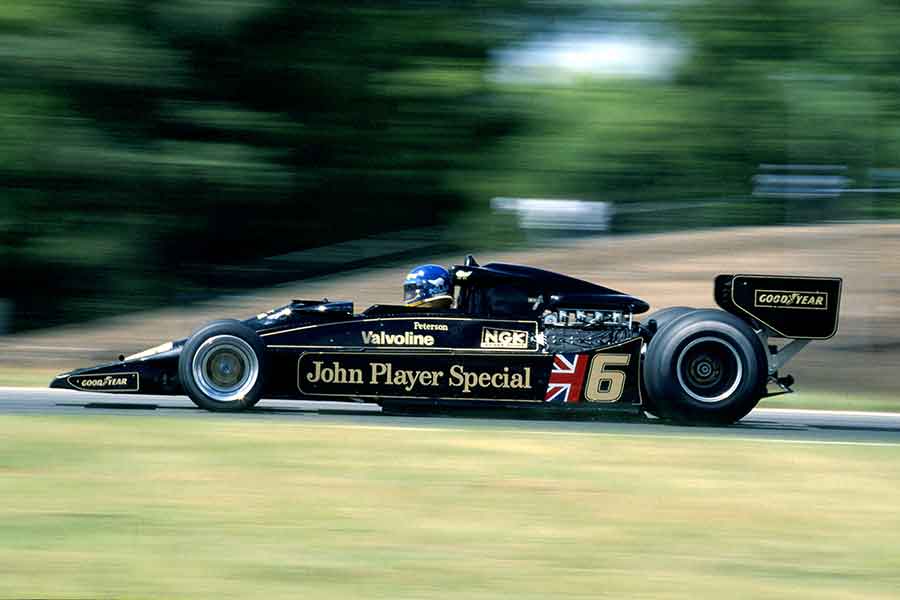Lotus 78 - Mario Andretti's Favorite F1 Car
The Lotus 78, designed by Colin Chapman and his team, was the car used by Lotus Formula 1 team during 1977 and 1978 World Championships.
Lotus 78 F1 John Player Special – Art By Jeff Harmer
Lotus 72 as a paragon
After quite disappointing performances by Lotus 77, Colin Chapman and his designers and engineers began work on a new model. Chapman’s main goal was to gain more downforce and high-speed stability with improved aerodynamics. However, as the base for the new car was used extremely successful Lotus 72. The new Lotus 78 was pretty similar in a wedge shape and internal layout, but wheelbase was longer, the aerodynamics was significantly improved, as well as weight distribution.
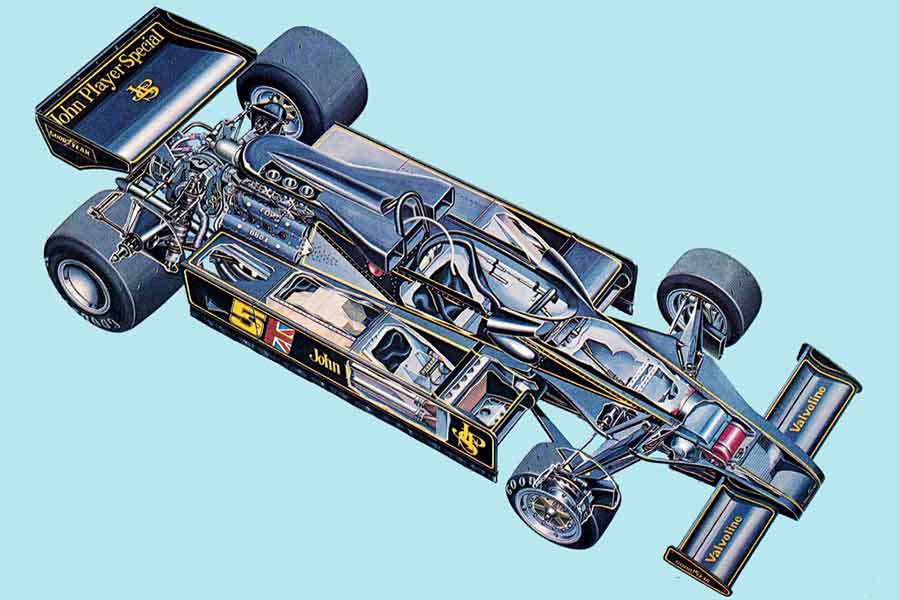
Lotus 78 cutaway
With a wing profile on the floor, the air under the car was accelerated, resulting in a low-pressure area. This low-pressure zone was sealed on both sides by a vertically movable skirt to maintain a slight contact with the track at all times. The honeycomb monocoque was very slim and light but because of that and increased stress created by ground effects, the car was hard to handle. On the both sides of the driver’s compartment, full-length side pods with the radiators created more ground effect. Chapman applied this solution after being inspired by Mosquito fighter bomber aircraft constructed by de Havilland. Conventional wings were fitted both front and rear for the stability at high-speed.
Lotus 78 was developed over the 1977 season
After the first tests were done, it was found that the car needs huge rear wing as the low-pressure area under the car was found to be too far forward. Rival cars were much faster than Lotus 78, so developed version of Ford Cosworth engine was delivered to the team. The car became faster but much more unreliable what result with five engine failures. That proved to be decisive in Mario Andretti’s attempt to win the title in 1977.
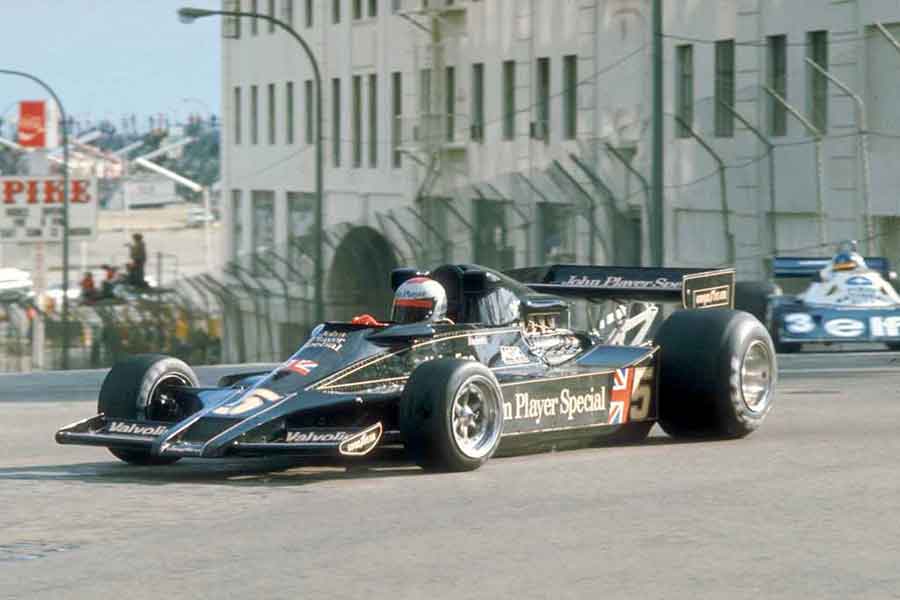
Mario Andretti in Lotus 78 at Long Beach, 1977
Another problem was oversteering caused by the rear suspension, which was directly in the path of the exiting air, which affected the stability of the back of the car. Some modifications were done over the season, but that problem always was present in a greater or lesser extent.
Andretti and Lotus were the best but…
The season of 1977 was full of mixed feelings for Lotus. Mario Andretti scored most wins that year but finished 3rd in the standings, behind Niki Lauda and Jody Scheckter. Lotus 78, or a ’Wing Car’ won a total of five races (Andretti 4, Gunnar Nilsson 1), more than any other constructors, but that still wasn’t enough for the title. Lotus finished the season as a vice-champion, losing to Ferrari.
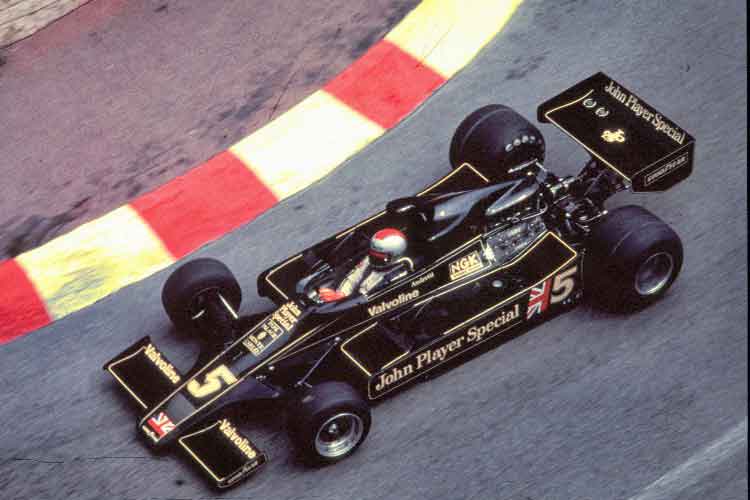
Mario Andretti in Lotus 78 colored in famous John Player Special livery 1977 Monaco Grand Prix
Chapman knew that he had a winner in his hands, but the poor reliability and a total of 15 retirements were too much. That’s why he had to make some changes for the 1978 campaign. Much of the honeycomb used for the chassis was replaced by aluminum sheets what increased the weight of the car. Even larger side pods were fitted to the car to maximize ground effects and the whole body was smoother.
Lotus 78 played its role in winning the 1978 titles
So, the new car, named Lotus 79 was born but wasn’t ready for the start of the season and Lotus team used the old but slightly modified 78 for the opening five rounds. Gunnar Nilsson left the and was replaced by his compatriot Ronnie Peterson. The season started well after Andretti won the opening race in Argentina. Peterson was the winner of the South African Grand Prix and later finished 2nd in Belgium, while Andretti finished 2nd at Long Beach.

Ronnie Peterson in Lotus 78
That results helped Lotus to comfortably win Constructors’ championship in 1978, while Andretti won his only Formula 1 title. However, the new Lotus 79 was introduced by the team in the Belgian Grand Prix at Zolder and played more important role in the assault to the trophies, but Lotus 78 also deserve plaudits.
Andretti: Lotus 78 gave the most satisfaction
“The Lotus 78 was much more fun to drive than 79 which had poor brakes. Both Ronnie and I were screaming about the brakes. Chapman didn’t believe us as he didn’t like drivers telling him about technical things. The Lotus 78 definitely was the car that gave me the most satisfaction. I should have won the championship with the 78 in 1977 but I ran out of gas in the very late stage at three races. Chapman used to pull the last liter or two of fuel out of the cars before the race as he wanted them to be as light as possible”, said once Mario Andretti.
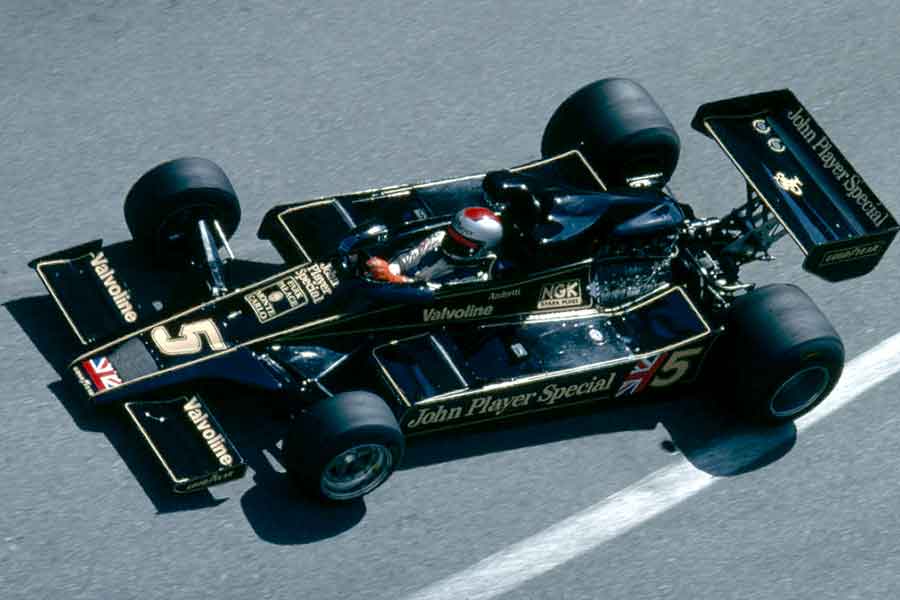
Lotus 78 was Mario Andretti’s favorite car
In all, the Lotus 78 took seven wins, had nine pole positions and seven fastest laps, and scored a total of 106 points in its career.
Lotus 78 technical specifications
| Chassis | Aluminium monocoque |
| Length | 4.547 mm |
| Width | 2.146 mm |
| Height | 914 mm |
| Weight | 578 kg |
| Front suspension | Upper rocker arm, lower wishbone, inboard spring/damper units |
| Rear suspension | Upper rocker arms, lower wishbones, inboard coil springs over dampers |
| Wheelbase | 2.741 mm |
| Front track | 1.702 mm |
| Rear track | 1.600 mm |
| Engine | Ford – Cosworth DFV V8 90º, 2.993 cc, mid-engined, longitudinally mounted, naturally aspirated |
| Power | 480 bhp / 358 kW at 10.600 rpm |
| Gearbox | Hewland FGA 400 5-speed manual |
| Brakes | Ventilated discs, all-round |
| Tyres | Goodyear |
| Fuel | Valvoline |
Photo: racem.org, wheelsage.org, slotforum.com


